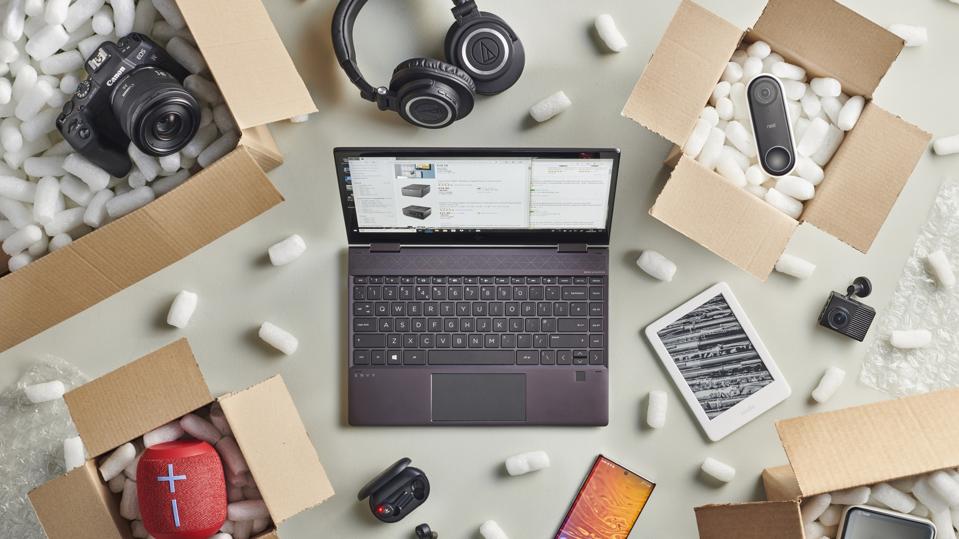Deinfluencing is a growing trend on TikTok where creators attempt to persuade audiences from overconsumption and falling victim to—oftentimes overpriced—social media trends, like dishing out over $400 for the AirPod Max, or paying around the same amount for the viral Dyson Airwrap.

A group of Black Friday online shopping purchases photographed in delivery boxes filled with polystyrene packing pellets.
Future Publishing via Getty Images
Key Facts
A Meta study found 54% of people either made a sporadic purchase in the moment or after seeing the service or product on Instagram.
Influencers using the online shopping platform LTK sold over $3.6 billion worth of products in 2022, according to the company, and over 18 million users use the platform on a monthly basis.
According to Twitter statistics, 53% of the social platform’s users are more likely to be the first to buy new products—users also view ads 26% more time on Twitter than any other platform.
Products and services oftentimes go viral on social media platforms thanks to the help of influencers, like the popular UGG Tasman Slippers, which sold out right before the holidays, and whose hashtag (#uggtasmanslippers) has over 19.3 million views on TikTok.
A 2022 report by InCharge Debt Solutions found over a third of people admit to overspending in order to “keep up with the fun” they see their peers having on social media.
The report also found 40% of Gen Z is willing to spend more on experiences rather than necessity, though 20% admit to not saving money in favor of either having these experiences or shopping.
Big Number
322.4 million. That’s how many times the #deinfluencing hashtag has been viewed on TikTok.
Overconsumption And The Environment
A subculture of the deinfluencing trend involves creators posting “anti-hauls” of products they either won’t buy or won’t repurchase. These are the exact opposite of the popular haul trend on TikTok where creators post about all the things they buy from their shopping trips, oftentimes in excess and high-volume.
TikToker Alyssa Kromelis told Forbes over the past two years she’s been using TikTok, she’s “seen more insane Amazon, Shein, Ulta, Target, etc. hauls than [she] can count.”
Maeve Galvin, global policy and campaigns director at non-profit organization Fashion Revolution, told Vogue hauls are “connected to gamification and the ‘sport of consumption’ when it comes to fashion.” A 2020 Princeton review found the fashion industry uses one-tenth of all water used to run factories and clean products. It also found 57% of all discarded clothes end up in landfills. A study published in Nature Reviews Earth & Environment found the fashion industry contributes to 92 million tons of waste each year and 79 million liters of water consumed.
Crucial Quote
Canadian deinfluencer Michelle Skidelsky told Forbes overconsumption is featured a lot on TikTok, making it “very easy to fall into the rabbit hole of buying things you see online in the hopes of buying yourself into a better life.”
Some brands have attempted to combat the fashion industry’s impact on the environment, like Patagonia, which transformed into a charitable trust in 2022 and donated profits from its $1.5 billion in annual sales to fight climate change.
Dupe Culture
“Dupe” is the short-form of duplicate, meaning a cheaper product made to resemble a more high end, expensive or designer version.
Dupe culture is heavily seen in the fashion world, where standout pieces from fashion houses are duplicated at less expensive prices by fast-fashion brands like Shien, Fashion Nova and Zara. For example, Rolling Stone reported on the viral $695 fairy dress made by designer Marcelo Gaia that was “duped” by several fast-fashion brands for cheaper alternatives. However, dupe culture has spilled over into other spaces like the beauty world, with beauty gurus like Laura Lee putting high-end makeup and their drugstore dupes up against each other.
Some TikTok creators have turned to dupe culture as an intersection with deinfluencing as a way to combat consumerism, with the #dupe hashtag having over 3.1 billion views. Some of the most liked videos on the deinfluencing hashtag feature creators sharing cheaper alternatives for high-end products, but according to Hannah Rosato, a creator at the forefront of the deinfluencing trend, this can be counterproductive.
Dupe culture is “still advocating for consumption,” and can come off as “predatory” when influencers have affiliate links to “duped” products in their bios, Rosato told Forbes. However, she believes there’s a silver lining to dupe culture by making “products more accessible” to those who otherwise wouldn’t be able to afford them.
This article was first published on forbes.com. All figures are in USD.


